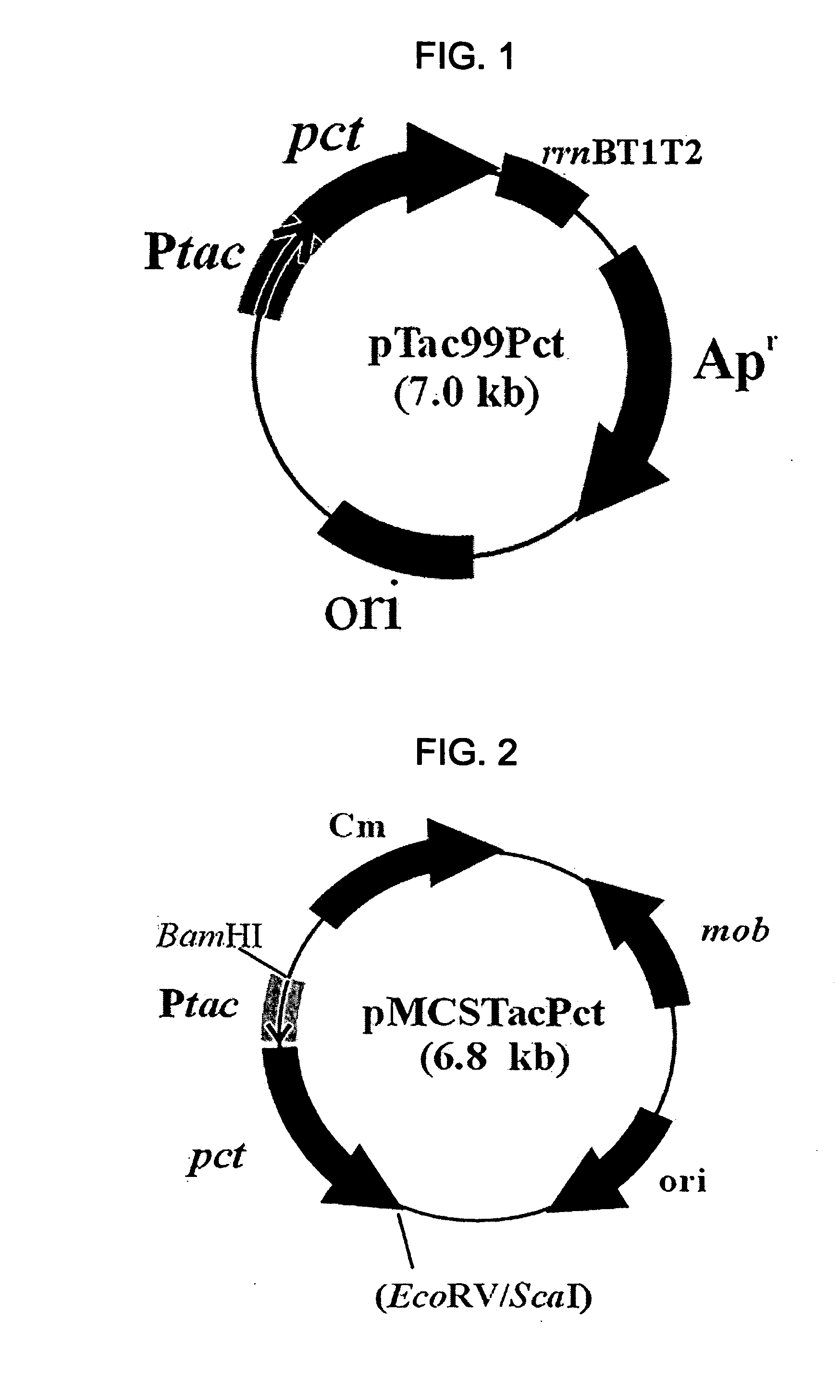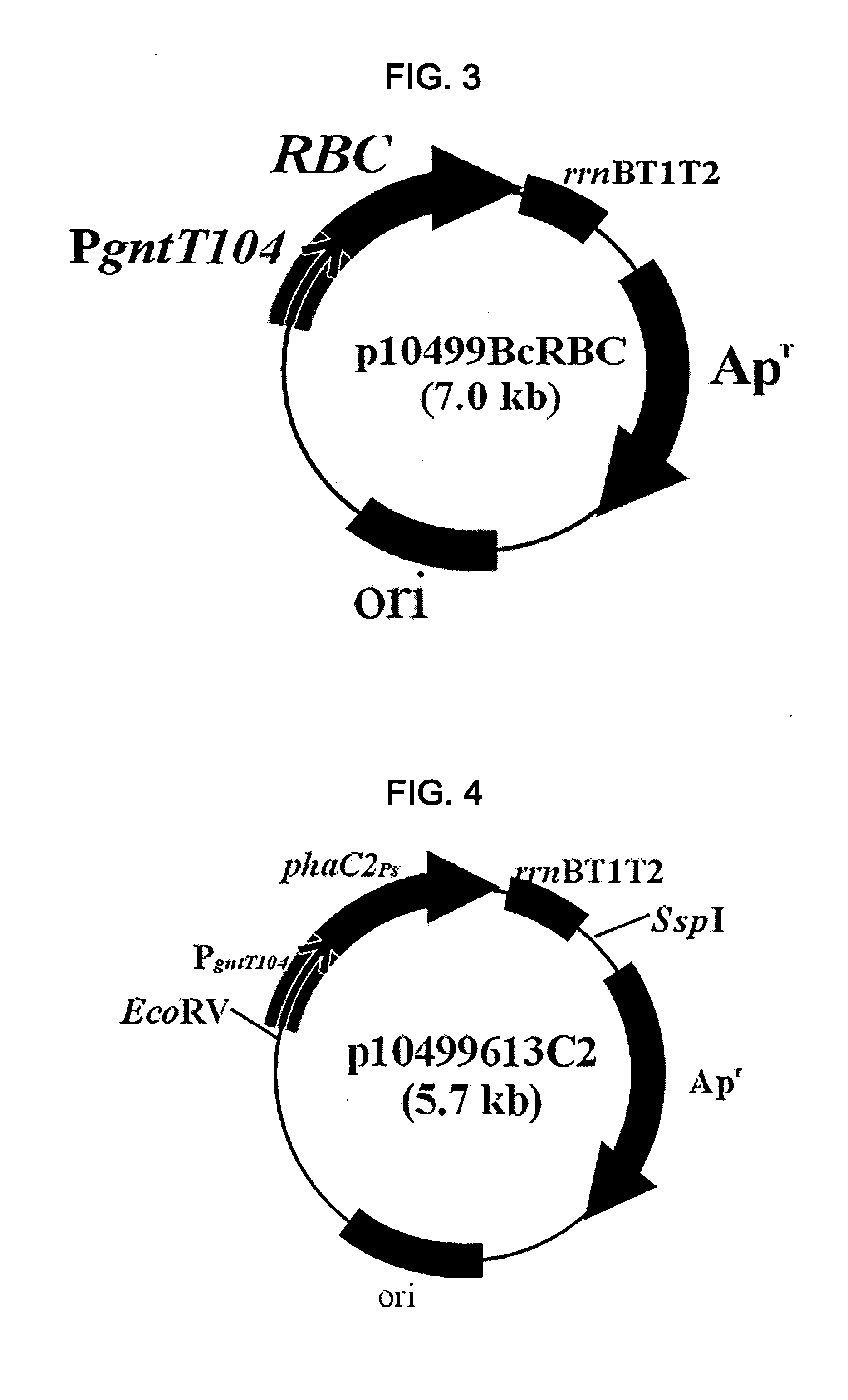Cells or plants producing polylactate or its copolymers and uses thereof
a technology of polylactate and copolymer, which is applied in the direction of bulk chemical production, transferases, applications, etc., can solve the problems of complex process for preparing pla of high molecular weight, easy to be removed, and no examples of natural production or production by recombinant cells
- Summary
- Abstract
- Description
- Claims
- Application Information
AI Technical Summary
Benefits of technology
Problems solved by technology
Method used
Image
Examples
example 1
Construction of Recombinant Vector Containing pct
[0062]Primers having basic sequences of shown below were synthesized based on the pct gene sequence (Selmer et al., Eur J. Biochem., 269:372, 2002) for PCR cloning of pct:
SEQ ID NO: 1:5′-ggaattcATGAGAAAGGTTCCCATTATTACCGCAGATGA-3′SEQ ID NO: 2:5′-gctctagattaggacttcatttccttcagacccattaagccttctg-3′
[0063]To amplify pct, PCR was carried out using chromosomal DNA of Clostridium propionicum as template and the above primers. PCR was performed under conditions of 30 cycles(denaturation at 94° C., for 50 sec annealing at 52° C., for 50 sec extension at 72° C., for 2 min). By examining the PCR reaction product by agarose gel electrophoresis, a 1.5 Kb gene fragment corresponding to pct was observed. After the pTac99A vector (Park and Lee, J. Bacteriol., 185:5391, 2003) was digested with EcoRI / XbaI enzyme, pTac99Pct recombinant expression vector was prepared by inserting pct into EcoRI / XbaI recognition site of pTac99A (FIG. 1). Also, pMCSTacPct was...
example 2
Construction of Recombinant Vector Containing a Gene Encoding PHA Synthase
[0064]To amplify phaRBC operon, PCR was carried out using chromosome DNA of Bacillus cereus as template and the following primers.
SEQ ID NO: 3:5′-ggaattcatgaattgtttcaaaaacga-3′SEQ ID NO: 4:5-cgggatccttaattagaacgctcttcaa-3′
[0065]PCR was performed under the condition of 30 cycles(denaturation at 94° C., for 50 sec annealing at 52° C., for 50 sec extension at 72° C., for 2 min),
[0066]Upon examination of the PCR reaction product by agarose gel electrophoresis, a 2.5 Kb gene fragment corresponding to phaRBC was observed. After p10499A vector(KR 10-0447531B1) was digested with EcoRI / BamHI enzyme, a p10499BcRBC recombinant expression vector was prepared by inserting phaRBC into the EcoRI / BamHI recognition site of p10499A (FIG. 3).
[0067]Also, a gene encoding PHA polymerase (phaC) derived from Pseudomonas sp. 61-3 was amplified and inserted into p10499A to prepare the recombinant expression vector p10499613C2(KR 10-044...
example 3
Construction of Recombinant Ralstonia eutropha and Preparation of Hydroalkanoate-Lactate Copolymer Using the Same
[0068]After recombinant Ralstonia eutropha(pMCSTacPct) was constructed by introducing pMCSTacPct prepared in Example 1 into Ralstonia eutropha NCIMB 11599, two-step culture was carried out. After recombinant Ralstonia eutropha was cultured in a NB medium(Nutrient Broth; 5 g / L of Peptone, 3 g / L of Beef extract) overnight, the strains recovered by centrifugation were cultured in a N-limited MR medium containing 2 g / L of lactate for 3 days. The composition of N-limited MR medium was as follows: 6.67 g of KH2PO4, 4 g of (NH4)2HPO4, 0.8 g of MgSO4 7H2O, 0.8 g of citric acid, and 5 mL of trace metal solution. Trace metal solution (per liter): 5 mL of 5M HCl, 10 g of FeSO4.7H2O, 2 g of CaCl2, 2.2 g of ZnSO4.7H2O, 0.5 g of MnSO4.4H2O, 1 g of CuSO4.5H2O, 0.1 g of (NH4)6Mo7O2.4H2O, and 0.02 g of Na2B4O2.10H2O
[0069]After the strains were recovered by centrifugation and freeze-dried,...
PUM
| Property | Measurement | Unit |
|---|---|---|
| Brinell hardness | aaaaa | aaaaa |
| Brinell hardness | aaaaa | aaaaa |
Abstract
Description
Claims
Application Information
 Login to View More
Login to View More - R&D
- Intellectual Property
- Life Sciences
- Materials
- Tech Scout
- Unparalleled Data Quality
- Higher Quality Content
- 60% Fewer Hallucinations
Browse by: Latest US Patents, China's latest patents, Technical Efficacy Thesaurus, Application Domain, Technology Topic, Popular Technical Reports.
© 2025 PatSnap. All rights reserved.Legal|Privacy policy|Modern Slavery Act Transparency Statement|Sitemap|About US| Contact US: help@patsnap.com



